yeovil people
James Corfield
Ironmonger of the Borough
James Corfield was born in Bridgwater in 1818. He was the eldest of the five children of James Corfield (1780-1851) and Elizabeth Grace née Cox (1788-1865). His siblings were Elizabeth Mary (1819-1902), Henry Cox (1823-1883), Ann Cox (1825-1848) and Mary (1827-1899).
Nothing is known of James' early life, but in the spring of 1840, at Sidbury, Honiton, Devon, he married Ann Pitfield (1816-1878), the only daughter of the late Thomas Pitfield. They settled in Yeovil and were to have six children, all born in Yeovil but only half attained adulthood; Eliza Anne (1841-1849), William Henry (1843-1927), Emily (1846-1846), Marian (1850-1918), Jessie Ann, known as Ann (1854-1919) and James Pitfield (1856-1857).
In the 1841 census, 25-year-old James was listed living in Peter Street with Ann and baby Eliza, together with his mother, two sisters - Elizabeth and Ann - and a female servant. James gave his occupation as an ironmonger.
In Hunt & Co's Directory of 1850, James had two listings; as an ironmonger and cutler of the Borough and also as an oil & colour warehouse. He was recorded several times as an ironmonger in the Churchwardens' Accounts between 1851 and 1856.
In 1851, James was noted as an investor in the South Western Railway Company.
The 1851 census listed James and Ann, together with their children William Henry and Marian (Eliza Anne and Emily both having died), an ironmonger's assistant, an ironmonger's apprentice and two domestic servants living above his shop premises in High Street. James described his occupation as 'Ironmonger employing 2 men'.
In late November 1854, during the Crimean War, the Yeovil Local Patriotic Fund was created as part of the national scheme to support widows and orphans of servicemen killed in action. Support in Yeovil was instantaneous. A list of subscribers was published in the Western Flying Post's edition of 12 December 1854. On first glance it may seem that people were being less than generous until it is realised the £5 in 1854 would be worth around £600 at today's value. The total amount listed was some £427 - in excess of £50,000 at today's value - and all raised in the first week of the appeal. James subscribed £1 to the fund (around £120 at today's value).
Slater's Directory of 1852 gave James two listings; as an ironmonger of High Street and as an agent for the Liverpool & London Fire & Life Insurance Company. The Post Office Directory of 1866 listed him as an ironmonger of High Street.
Ann was absent from home at the time of the 1861 census, but James and his two daughters, Mary Ann and Jessie Ann, together with an apprentice, cook, nurse and housemaid were living above the shop premises. James simply gave his occupation as an ironmonger.
In May 1869 Thomas Denner and Henry Stiby acquired James' ironmongery business. Whether James had enough of ironmongery, or if the business was beginning to flag is unknown. However, by the time of the 1871 census 52-year-old James was working as an 'Insurance Agent & Collector of Income Tax'. He had moved Ann and daughter Marian to a house in The Park where they lived with a domestic servant.
Ann died in Yeovil in the summer 1878. She was 62 years old. James died, also aged 62, in Yeovil on 2 October 1880. His will was proved at Taunton the following March and his estate was valued at 'under £300' (around £30,000 at today's value).
map
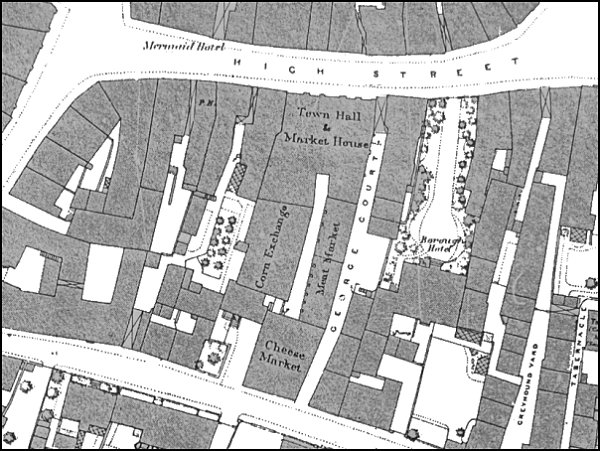
The 1886 Ordnance Survey showing the Town Hall & Market House, the Corn Exchange, Meat Market and the Cheese Market. George Court runs between High Street at the top of the map and South Street at the bottom and James Corfield's ironmongery was the building in High Street immediately right of George Court.
gallery
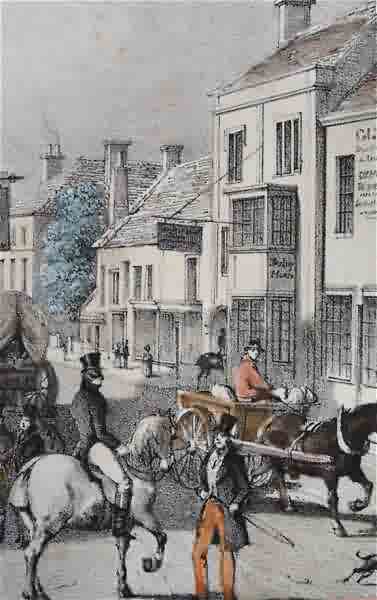
From my
collection. This
lithograph
features in my
book "Lost Yeovil"
It is probable that the building to the right of the tree was the former George Inn (or at least, the site of it). However the last record of the George Inn was in 1770 and certainly by 1820 the inn formerly known as the Three Cups in Middle Street was known as the George; therefore this may be the same building, or it may have been rebuilt - although the first floor fenestration certainly does not match later photographs. Shortly after the time of this 1839 image, the building became the ironmongery of George Crocker, until around 1850, when it became the ironmongery of James Corfield.
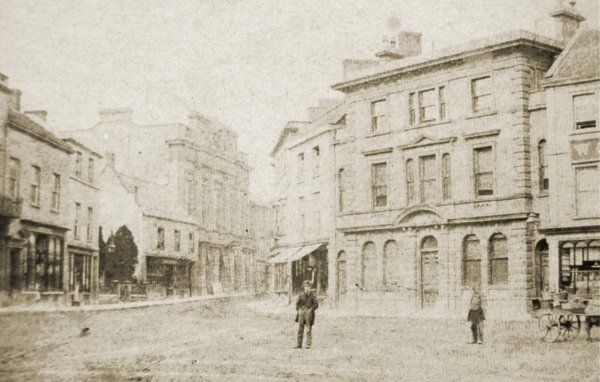
A very early photograph, dating to about 1860, shows High Street as seen from the Borough. Notice that at this stage the Town Hall lacks a clock tower which was not to be erected until 1864 but taken down in 1887 as unsafe. James Corfield's ironmongery business occupied the two-storey building to the left of the Town Hall.
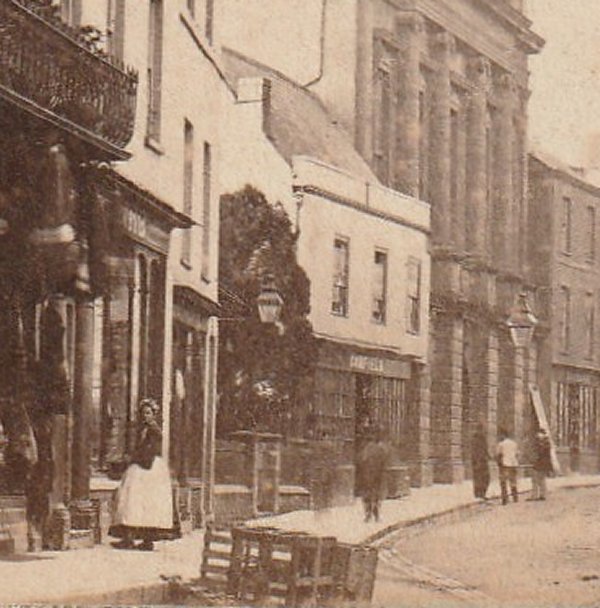
From my
collection
James Corfield's shop premises (his name is visible above the door), from a carte de visite taken by John Chaffin in 1868 - just a few months before he sold it to Messrs Denner and Stiby.

An advertisement placed by Denner & Stiby (Late Corfield) in the 14 May 1869 edition of the Western Gazette informing the 'Gentry, Clergy, and Public generally' of their new enterprise.
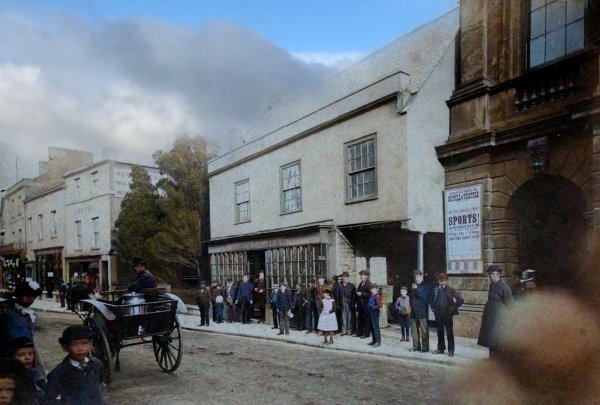
From the Stiby
Collection
(colourised),
Courtesy of South Somerset Heritage Collection
Denner & Stiby's shop photographed in 1883, probably by Henry Stiby who was a keen amateur photographer and left a good record of photographs of Yeovil. Note under the right of the three first floor windows is the entrance to the less-than-savoury George Court.
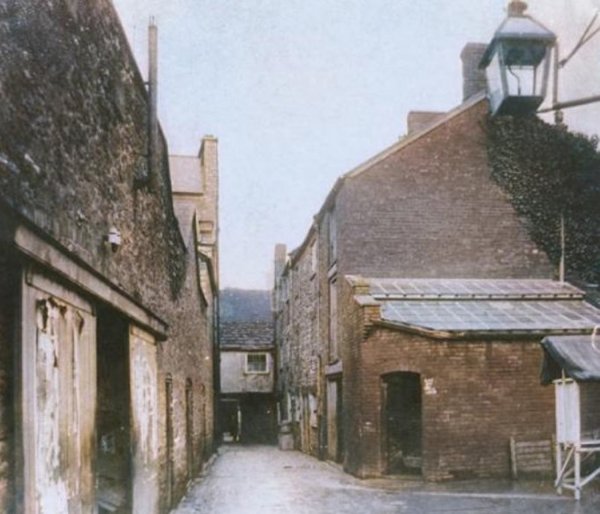
This
colourised photograph
features in my
book 'Secret Yeovil'.
This photograph dates to about 1915 and looks north along George Court towards High Street with the meat market at left and slum housing at right. At the end the 'flying freehold' is built over the tiny entrance to George Court - showing one of James Corfield's bedroom windows.
